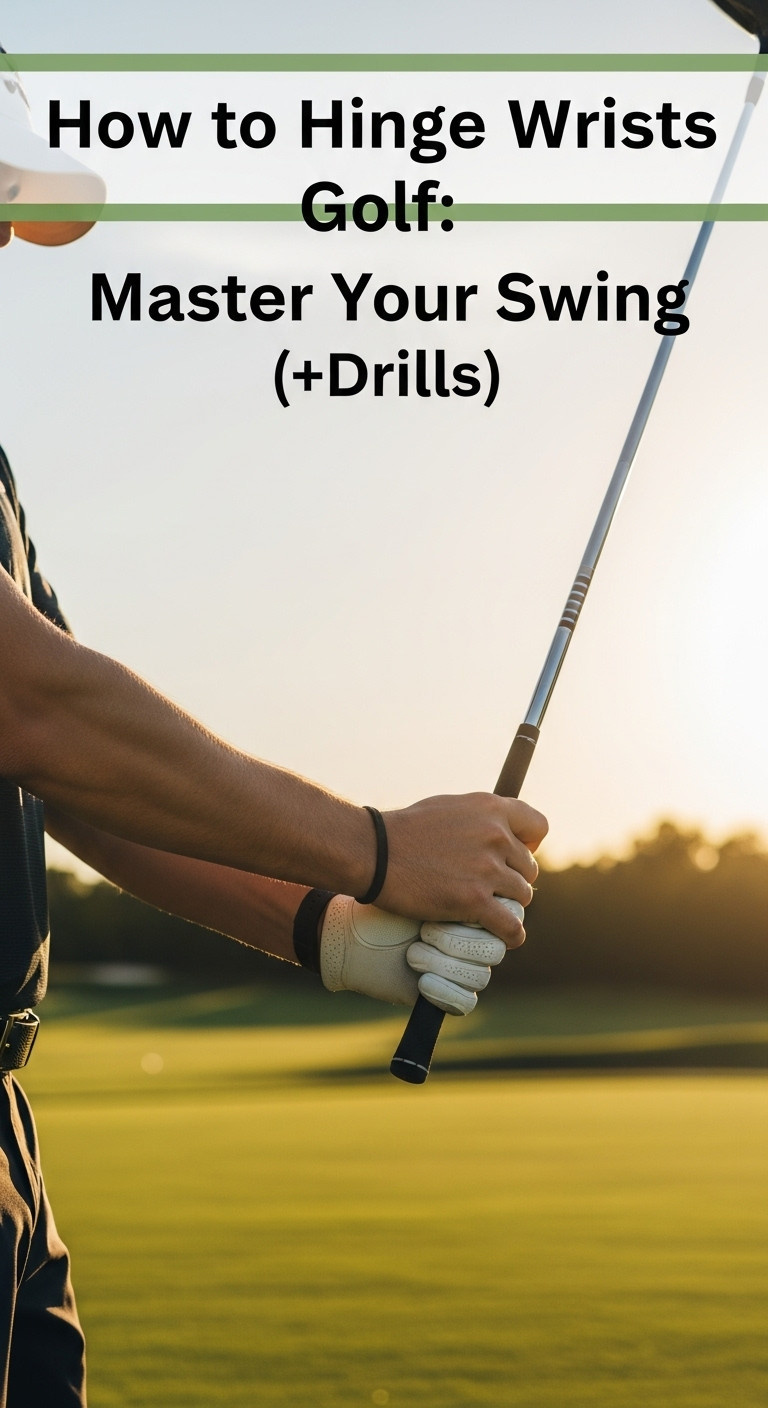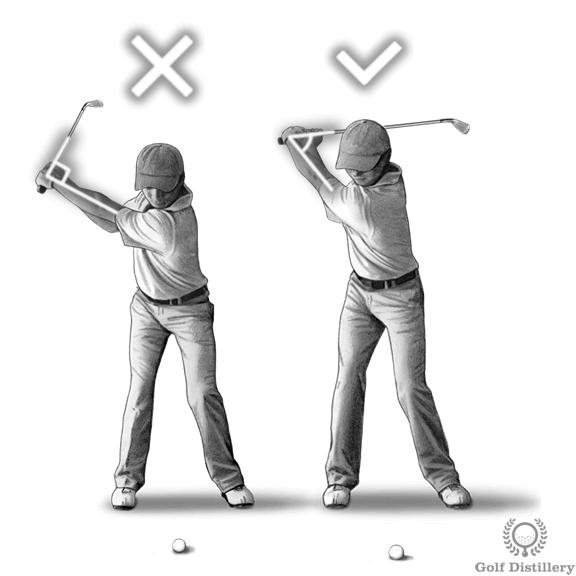As an Amazon Associate GolferHive.com earns from qualifying purchases.
How to Hinge Wrists Golf: Master Your Swing (+Drills)
Ever wonder how smaller players generate so much power? The secret often lies in mastering one single movement. For many golfers, the concept of how to hinge wrists in golf is a source of constant confusion, leading to weak shots, inconsistent contact, and a frustrating loss of distance. This guide will eliminate the guesswork, breaking down the precise mechanics, timing, and drills you need to unlock the power and consistency you’ve been searching for.
To hinge correctly, your lead wrist performs radial deviation (thumb to forearm) and your trail wrist extends (bends back), creating a 90-100 degree angle between the lead arm and club shaft at the halfway point of the backswing. This fundamental movement is a primary source of stored energy.
Leveraging extensive analysis of expert instruction and swing biomechanics, this guide unpacks the proven techniques and critical insights needed to master your wrist hinge. We’ll cover the exact mechanics for each wrist, diagnose common faults like “casting,” and provide actionable drills that build perfect muscle memory.
Key Facts
- Primary Power Source: According to analysis from sources like Golf Monthly, proper wrist hinge is a fundamental source of leverage and power, acting like a whip to generate significant clubhead speed.
- Optimal Angle: A key checkpoint for a proper hinge is achieving a 90-100 degree angle between your lead arm and the club shaft when your arm is parallel to the ground in the backswing.
- Lead Wrist Mechanics: The main action for the lead wrist (left wrist for a right-handed golfer) is “radial deviation,” the motion of your thumb moving up toward your forearm.
- Trail Wrist Mechanics: The trail wrist (right wrist for a right-handed golfer) complements this by performing “extension,” where it bends backward with the knuckles moving toward the forearm.
- Common Faults Have Names: The two most common errors are “casting,” which stems from over-hinging and releasing the angle too early, and under-hinging, which results in a major loss of potential power.
What is Wrist Hinge in Golf and Why Does it Matter?
As established by authoritative sources like Golf Monthly, wrist hinge is a fundamental golf swing movement where the wrists bend to create leverage, acting as a primary source of power, clubhead speed, and control over the ball’s trajectory. It’s the engine of your swing, the critical link where energy is stored in the backswing and unleashed through impact. Without a proper understanding of how to hinge wrists golf, players often leak power and struggle with consistency.

Think of it this way: a powerful golf swing is less about brute strength and more about efficient energy transfer. The wrist hinge is the mechanism that facilitates this transfer. Here’s exactly why it’s so critical:
- Power and Clubhead Speed: The most significant benefit is raw power. A correct wrist hinge creates a powerful lever system. Just like cracking a whip, the stored angle in your wrists releases at incredible speed through the downswing, multiplying the force you apply and dramatically increasing clubhead speed.
- Optimal Angle of Attack: For crisp, pure iron shots, you need to hit down on the ball. Proper wrist hinge is crucial for creating and maintaining the correct “angle of attack,” which allows you to compress the ball against the clubface for that penetrating flight and optimal spin.
- Clubface Control & Consistency: While a source of power, the wrist hinge is also a key component of control. An incorrect hinge—either too much or too little—can leave the clubface open or closed at impact, leading to hooks and slices. A mechanically sound hinge promotes clubface stability, leading to far more consistent and predictable shots.
The Correct Mechanics: How to Hinge Your Wrists Properly
To learn how to hinge wrists golf effectively, you must understand that it’s not a single, isolated movement. It is a synergistic action between your lead and trail wrists, each performing a distinct function. When they work together correctly, they create what experts call a “lovely, powerful position in the backswing.”
A great checkpoint is when your lead arm is parallel to the ground; the club shaft should form roughly a 90-degree angle with it. This indicates you’ve stored the optimal amount of energy.
Here’s a clear breakdown of what each wrist should be doing:
| Wrist | Primary Action | Key Feeling/Position |
|---|---|---|
| Lead Wrist (Left) | Radial Deviation | Thumb moves up and towards the inner part of your forearm. |
| Trail Wrist (Right) | Extension | Knuckles bend back towards the top of your forearm, supporting the club. |
The lead wrist’s radial deviation is the primary hinging motion that creates the angle. Simultaneously, the trail wrist’s extension helps support the weight of the club at the top of the swing and places it in a powerful delivery position. These two movements are not separate; they blend together to set the club perfectly on plane.
Timing Your Hinge: When and How Much to Set Your Wrists
One of the most debated topics when learning how to hinge wrists golf is timing. Should you consciously set your wrists early, or should it happen naturally? The answer, for most golfers, is the latter.
The wrist hinge should occur naturally. If you start the backswing with the chest and have a one-piece takeaway with no tension in the wrists, the club’s momentum will hinge the wrists.
This concept of a “one-piece takeaway” is crucial. It means your hands, arms, and torso start the backswing together as a single, connected unit. By doing this, you allow the weight and momentum of the clubhead to create the hinge for you gradually and smoothly. Forcing a conscious, early hinge can lead to a disconnected swing and a loss of rhythm.
Here are a few key checkpoints for timing your wrist hinge:
- The Takeaway: As you start back, focus on turning your chest and shoulders. Your wrists should remain relatively passive.
- Club Parallel to Ground: When the club shaft is parallel to the ground during the takeaway, you should feel a slight, natural hinge setting in. Data from expert analysis, such as that provided by HackMotion, suggests this is where you should have achieved about 15-20 degrees of radial deviation.
- Top of the Backswing: The hinge should feel fully “set” by the time you reach the top of your backswing, with the lead wrist flat and the club supported.
Quick Fact: According to experts, if you start your backswing correctly with your chest and maintain tension-free wrists, the club’s own weight and momentum will create the hinge for you.
Common Wrist Hinge Problems & How to Fix Them
Understanding the mechanics is one thing, but executing them under pressure is another. Many golfers struggle with getting the right amount of wrist hinge, which leads to two primary faults. Before you can fix your issue, you need to correctly diagnose it.
As you read the descriptions below, which one sounds more like your typical miss-hit? This is your key to improvement.
| Symptom | Likely Problem | Result |
|---|---|---|
| Clubhead passes hands too early in downswing; thin or fat shots. | Too Much Hinge (Over-hinging) | A “cast” or “flip,” leading to a severe loss of power and poor contact. |
| Weak, high shots with little distance; feeling of no “snap” at impact. | Too Little Hinge (Under-hinging) | A massive loss of leverage and clubhead speed; inability to compress the ball. |
Over-hinging is often caused by an overly “handsy” takeaway, where the player breaks their wrists immediately instead of starting the swing with their body. This leads to the dreaded “cast,” where the stored angle is released far too early in the downswing, wasting all the potential energy before the club even reaches the ball.
Under-hinging, on the other hand, often comes from being too stiff or rigid in the arms and wrists. The player fails to create the necessary leverage, resulting in a swing that relies solely on arm strength and produces weak, ineffective shots. The solution for both issues lies in targeted, corrective drills.
6 Effective Drills to Master Your Wrist Hinge (2025 Update)
The only way to truly learn how to hinge wrists golf is through practice and feel. Theory is great, but drills build the muscle memory required to make a great swing automatic. Based on research from credible sources like HackMotion, these exercises are designed to fix specific faults and ingrain the correct feelings of a powerful and controlled wrist hinge.
Drill 1: Connected Takeaway Drill (For Early Over-Hinging)
This drill is for the player who gets too “handsy” and sets the club too early. It corrects an early, handsy takeaway by forcing your arms and body to move as one connected unit.
- Step 1: Take your normal setup with a mid-iron.
- Step 2: Place the butt end of the club against your stomach.
- Step 3: Make slow, half-backswings, focusing on keeping the club connected to your stomach.
- Step 4: The goal is to feel your torso, chest, and shoulders initiating the swing, not your hands. This promotes a “one-piece takeaway” and prevents an early, uncontrolled hinge.
Drill 2: Preset Wrist Hinge Drill (To Feel the Correct Position)
For those who under-hinge, this drill helps you feel the correct amount of hinge and how to maintain it.
- Step 1: Take your address position.
- Step 2: Without turning your body, hinge your wrists until the club shaft is parallel to the ground. Your lead wrist should feel flat, and your trail wrist extended. This is the position you want to achieve halfway back.
- Step 3: From this preset position, simply rotate your body to complete the backswing.
- Step 4: Swing through to the finish. This isolates the feeling of a full hinge powered by body rotation.
Drill 3: No Wrist Hinge Feel Drill (For Chronic Over-Hingers)
This drill uses exaggeration to find the middle ground. If you constantly over-hinge, actively trying to feel no hinge often results in the perfect amount.
- Step 1: Set up normally.
- Step 2: Make slow, deliberate backswings with the conscious thought of keeping your wrists as rigid and un-hinged as possible.
- Step 3: You’ll find that the club’s momentum still creates a natural hinge. For someone who over-hinges, this “no hinge” feel will likely be much closer to the correct position.
Drill 4: Towel Compression Drill (For Better Impact)
This drill is excellent for ensuring you maintain your hinge into the downswing and achieve proper shaft lean at impact, preventing a “flip.”
- Step 1: Place a small towel on the ground about a foot in front of your golf ball.
- Step 2: Take your setup and hit the shot as you normally would.
- Step 3: The goal is to hit the ball first and then have the club continue downward to strike the towel. This is only possible if you maintain your wrist hinge and lead with your hands, which promotes a firm lead wrist and a powerful, compressed strike.

Drill 5: Hit Hard, Stop Quick Drill (To Control the Release)
This drill teaches you how to release the club’s speed through the ball without flipping your wrists before impact.
- Step 1: Set up to a golf ball.
- Step 2: Take a full backswing.
- Step 3: Swing down as hard as you can, but with the intention of stopping the clubhead immediately after it makes contact with the ball.
- Step 4: This forces your body and wrists to brace and stabilize through impact, preventing an early release and training you to deliver speed at the right moment.
Drill 6: Wrist Hinge Checkpoint Drill (To Verify Your Angles)
This is a simple but effective drill to do at home or on the range to check your positions.
- Step 1: Take your setup and begin your backswing slowly.
- Step 2: Stop when the club shaft is parallel to the ground.
- Step 3: Check your wrists. Is your lead wrist flat or slightly flexed? Is your trail wrist slightly extended? Have you achieved that 15-20 degrees of radial deviation?
- Step 4: Continue to the top and check again. Is the angle between your lead arm and the shaft approximately 90 degrees? Use a mirror or your phone camera to verify these key positions.
Advanced Applications: How Pros Adjust Wrist Hinge for Different Shots
Once you understand the fundamentals of how to hinge wrists golf, you can begin to use it as a tool to control ball flight. Wrist hinge isn’t a rigid, one-size-fits-all mechanic. Tour professionals constantly manipulate the amount and timing of their hinge to produce different shots. Analysis from sources like Golf Digest, featuring top instructors like Mark Blackburn, confirms this is a high-level skill.
- For Low, Controlled Shots: When pros need a low-flighted, “stinger” wedge, they will consciously limit their wrist hinge. By focusing more on body rotation and keeping the wrists quieter, they de-loft the club and produce a boring, controllable trajectory that is ideal in windy conditions.
- For High, Soft Shots: Conversely, to hit a high, soft shot over a bunker to a tight pin, a pro will increase their wrist hinge in the backswing. This promotes a fuller, faster release of the clubhead through impact, adding loft and spin to the ball so it stops quickly on the green.
- Driver vs. Irons: While the core mechanics are similar, the feel can be different. With a driver, the longer shaft and wider swing arc create a more gradual and sweeping hinge. With a short iron, the hinge can feel a bit quicker and more abrupt due to the more upright swing plane.
- Wrist Hinge for Senior Golfers: As golfers lose flexibility, a full 90-degree hinge may not be possible or even desirable. Many senior golfers find success with a slightly earlier and more conscious wrist set to ensure they are generating as much leverage as possible within their physical limits.
Pro Tip: Next time you’re at the range, try hitting three wedges: one with minimal hinge, one with normal hinge, and one with an exaggerated hinge. Notice the difference in trajectory.
To aid your practice and help you feel the correct positions, investing in some simple golf swing training aids can be incredibly beneficial. These tools are designed to provide instant feedback on your wrist angles and swing plane, accelerating your learning curve.
FAQs About how to hinge wrists golf
Here are answers to some of the most common questions golfers have about mastering their wrist hinge.
How do you properly hinge your wrists in the golf swing?
Properly hinging your wrists involves a combination of radial deviation in the lead wrist (thumb toward forearm) and extension in the trail wrist (bending backward). This action should happen gradually during the backswing, creating a roughly 90-degree angle between your lead arm and the club shaft at the top.
Do wrists hinge naturally in the backswing?
Yes, for most golfers with good fundamentals, the wrists should hinge naturally. A “one-piece takeaway” initiated by the chest and shoulders, combined with tension-free wrists, allows the momentum and weight of the clubhead to create the hinge automatically without any conscious or forced effort.
How much wrist hinge should I actually have?
The ideal amount is a 90-100 degree angle between your lead arm and the club shaft when your lead arm is parallel to the ground and at the top of the backswing. However, this can vary based on flexibility and the club you are using. The key is to create enough leverage for power without over-hinging and losing control.
Does Tiger Woods hinge his wrists?
Absolutely. Tiger Woods is known for having a powerful and efficient wrist hinge. His swing demonstrates a classic example of setting the wrists to create leverage at the top of the backswing and maintaining that angle deep into the downswing to generate incredible clubhead speed and compression at impact.
Should I hinge my wrists the same way for my driver and my irons?
The fundamental mechanics are the same, but the feel and timing might differ slightly. A driver’s longer shaft and flatter swing plane often lead to a more gradual, sweeping hinge. With shorter irons and a more upright swing, the hinge can feel like it sets a bit sooner and more vertically.
What happens if I have too much wrist hinge?
Too much wrist hinge, or hinging too early, often leads to a “cast.” This is when you un-hinge your wrists prematurely at the start of the downswing, releasing all the stored energy before you reach the ball. This results in a significant loss of power, poor contact (thin or fat shots), and a loss of control.
Final Thoughts: Mastering Your Hinge for a Better Golf Game
Learning how to hinge wrists golf is not about finding a single secret move; it’s about understanding a fundamental component of the swing that unlocks power, control, and consistency. By moving away from conscious manipulation and trusting a connected takeaway, you allow the club’s momentum to create a natural, powerful lever for you.
Your path to a better hinge starts now.
* Diagnose your fault: Are you over-hinging and casting, or under-hinging and losing power?
* Focus on the feel: Use the drills outlined in this guide to ingrain the correct sensations of a proper hinge.
* Practice with purpose: Don’t just hit balls; work on a specific drill with each practice session to build lasting muscle memory.
Stop guessing and start practicing. Take one drill from this guide to the range this week and focus only on that feeling. You’ll be amazed at the results in your ball striking, distance, and overall confidence on the course.
Last update on 2025-12-06 / Affiliate links / Images from Amazon Product Advertising API

